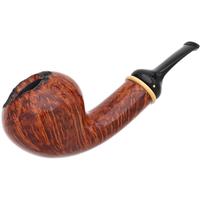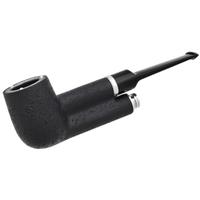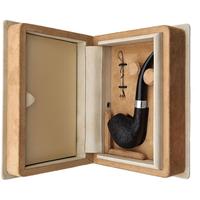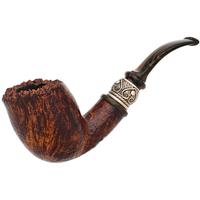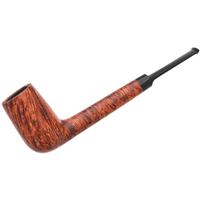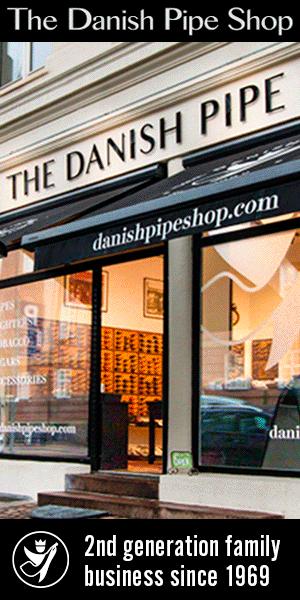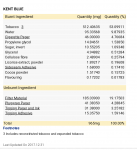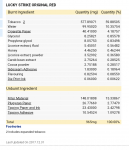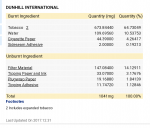Do All Mass Market Cigarettes Use Burley Tobacco?
- Thread starter eugenepark
- Start date
You are using an out of date browser. It may not display this or other websites correctly.
You should upgrade or use an alternative browser.
You should upgrade or use an alternative browser.
- Status
- Not open for further replies.
That's a good question. Never having smoked cigarettes, I have no idea, but my impression is that Virginia leaf was co-equal with burley as an ingredient in manufactured cigarettes (as opposed to roll your own). North Carolina was a major cigarette manufacturer in Durham and Winston-Salem. Richmond, Va., was another major center.
A quick search says Camels cigarettes by R.J. Reynolds have Turkish and Virginia leaf, for example.
A quick search says Camels cigarettes by R.J. Reynolds have Turkish and Virginia leaf, for example.
Last edited:
Canadian cigarettes are highly regulated. I’m not sure of the details, but they all seem to be straight Virginia.
Most US cigarettes are flue cured, or mix thereof. Marlboro Red Are so named for their blend of red flue cure. Camels are a flue cure and turkish blend. PalMals are mostly reds also.
There is some burley in most mixes, but what gave you the idea it was mostly burley?
The cigarette industry gives us almost all of our flue cure and color cured for the pipe industry.
There is some burley in most mixes, but what gave you the idea it was mostly burley?
The cigarette industry gives us almost all of our flue cure and color cured for the pipe industry.
Canadian cigarettes are 100% flu cured virginia. That's all we grow here so that's all we get. We covet those fancy american smokes.
It actually put me off from straight virginia pipe tobacco(I don't smoke cigs anymore) for a while cause it tasted to cigarettey to me, and burley tastes distinctly not-cigarettey to us Canadians. Until I started stoving my whole leaf virginia, then I started to enjoy virginia tobaccos much more.
It actually put me off from straight virginia pipe tobacco(I don't smoke cigs anymore) for a while cause it tasted to cigarettey to me, and burley tastes distinctly not-cigarettey to us Canadians. Until I started stoving my whole leaf virginia, then I started to enjoy virginia tobaccos much more.
That's a good question. Never having smoked cigarettes, I have no idea, but my impression is that Virginia leaf was co-equal with burley as an ingredient in manufactured cigarettes (as opposed to roll your own). North Carolina was a major cigarette manufacturer in Durham and Winston-Salem. Richmond, Va., was another major center.
A quick search says Camels cigarettes by R.J. Reynolds have Turkish and Virginia leaf, for example.
I love Camels for that very reason. I stopped buying them because they only do the blue mild version in the UK now?.
I looked on a site that sold foreign cigarettes to the UK a couple of years ago and was amazed at all the different Camel varieties that America gets. Iirc there were ones called "wides" I wouldn't have minded trying them and some of the others. It was an 800 cigarette minimum order though, which with our customs was too rich for my blood.
I agree that Canadian cigarettes are 100% Virginia, and that most American blends have a little bit of burley. I have read numbers from 10-30%. Then you have some that have oriental tobacco in a small amount in brands like Camel and Nat Sherman.
And then you've got European smokes like Drum and Gitannes which contain a little fire cured.
And there's kreteks and presumably unflavored East Asian cigarettes which contain sun cured strains.
And then you've got European smokes like Drum and Gitannes which contain a little fire cured.
And there's kreteks and presumably unflavored East Asian cigarettes which contain sun cured strains.
Do a deep search to find out what cigarettes' are really made of.
You will also have to keep in mind that the terms that we use in the pipe world does not carry over into the rest of the tobacco world. Farmers, for the most part do not sue the same categories that we use, and manufacturers use their own categories. I found when researching growing and curing Virginias that farmers don't grow Virginias, they grow bright leaf, and in the curing aspect of manufacturers, they flue cure and color cure. The main seeds stock is VAGold25 or some variation thereof. But, their is Ukrainian, cherry red, Canadian, etc... all in the bright leaf vein that needs to be flu cured. There's really not much of a difference between bright leafs and burleys.Do a deep search to find out what cigarettes' are really made of.
Pipe tobacco tends to use the leaf below the seco area of the plant, and the reason why cigarettes are stronger is because they use mostly the leaf in the seco.
Cigarettes came about in the early 1900's from people rolling pipe tobaccos. Pipe tobacco was stronger then, most places in the US wasn't selling corporate produced tobaccos, most people just bought tobacco like a produce, twists and such at the General store. It was the invention of the French papers that are used in rolling. Flue Cured tobaccos came about in the late 1800's. But, cigarettes were not produced in packs until 1920's. There were a few companies that made them earlier, but these were a novelty than the status quo. And, even up till the 1950's most cigarettes were hand rolled from multi use tobaccos.
It wasn't till the cigarettes companies had to start regulating how much nicotine and tars were in the tobaccos that they started squeezing all juices from the tobacco for cigarettes and then reformulating the juices and then rehydrating the cellulose left behind from the juicing to control these things. But, this is in only in pre-rolled packaged cigarettes. Most RYO is not pressed and rehydrated, making it very similar to pipe tobacco, and I sometimes smoke it in my pipes. Very good, IMO.
But, cigarettes were made possible because of flu curing and French papers. If they were burley, they'd have a deeper, less sweet flavor. Try rolling a burley sometime and trying it... it's nothing like a manufactured cigarette at all.
I seem to recall reading somewhere about a cigarette manufacturer was found to be including cardboard in their recipe! I forget who or when but I certainly read about it.
Regards,
Jay.?
Regards,
Jay.?
Probably Dunhill.?I seem to recall reading somewhere about a cigarette manufacturer was found to be including cardboard in their recipe! I forget who or when but I certainly read about it.
Regards,
Jay.?
Winston and Nat Shermans from my experience were Burley - Most cigarettes of today contain very little tobacco - They figure you are smoking the paper in the wrapper so what they do is homogenize mostly Virginia with paper(Yes Paper) and spray it with Sugar, Saltpeter, Nicotine, and Ammonia - roll it up in nasty firesafe paper and package it up for lung disease.
Cellulose is what is left when all of the juices are removed, so that when the juices are all modified with the correct dosages of nicotine and tar, and the added flavorings, and then the cellulose is then rehydrated with the mix. So, when people see cellulose they think "cardboard" but that is not true.I seem to recall reading somewhere about a cigarette manufacturer was found to be including cardboard in their recipe
This what I got when I toured a cigarette plant back in college. A friend of mine's dad was a manager there, and we got free cartons of cigs for visiting. SCORE!!!
Actually, all through grad school he kept us supplied in Free Camels. It helped a lot being struggling grad students.
Wow, where did you get this info?Winston and Nat Shermans from my experience were Burley - Most cigarettes of today contain very little tobacco - They figure you are smoking the paper in the wrapper so what they do is homogenize mostly Virginia with paper(Yes Paper) and spray it with Sugar, Saltpeter, Nicotine, and Ammonia - roll it up in nasty firesafe paper and package it up for lung disease.
Winstons are actually mostly Flue cured, with a little white burley for flavor and an added nic boost.Winston
I have no idea what a Nat Sherman is.
I know I tasted burley forward in Wiston - I loved 'em I used to tear off the filter - Nat's were a latakia burley blend - I think it's the same as Nat 536Winstons are actually mostly Flue cured, with a little white burley for flavor and an added nic boost.
I have no idea what a Nat Sherman is.
I was researching it - it all stemmed to the beginning of tar content regulation - They noticed that more paper kept 'tar label' lower and more appealing to health and public view.Wow, where did you get this info?
When we went and watched the process, when the tobacco was squeezed of all juices, it is technically "paper" being just the cellulose of the leaf left behind. But, it is rehydrated back with the reformulated juices. I think that the anti-smoking groups started huge misinformation campaigns, and started a lot of the misconceptions about cigarettes that still are floating around today.I was researching it - it all stemmed to the beginning of tar content regulation - They noticed that more paper kept 'tar label' lower and more appealing to health and public view.
Don't get me wrong, I hate the damned eyes out of the cigarette industry for blatantly lying to us for decades. They flat out lied to us. But, you have to laugh at some of the rumors about cigarettes that are floating about.
Also, there are three different types of companies most tobaccos have to go through before they get into our pipes. Farmers don't flu cure their own tobaccos, and there are very few, very very very few actual farmers left. So, if you smoke Virginias, you had better be nice to the cigarette industry. Because without them, there AIN'T no more Virginias. Of course, it isn't "treated" the same way cigarette tobacco is with the hydration process, but it is coming through their manufacturers.
I took these screenshots a long time ago from British American Tobacco's website. It's no longer available. Note the use of expanded tobacco in all of them and reconstituted tobacco in Kent. Dunhill is clearly the most unadulterated.
Also, RYO tobacco that come in pipe cut get a bad wrap. They are actually very good quality tobaccos that smoke great in a pipe. We have several other member that enjoy it as well.
- Status
- Not open for further replies.



